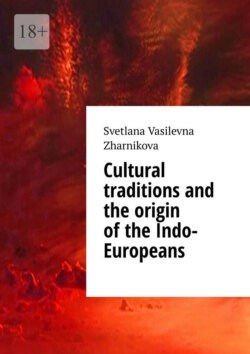Cultural traditions and the origin of the Indo-Europeans

Реклама. ООО «ЛитРес», ИНН: 7719571260.
Оглавление
Группа авторов. Cultural traditions and the origin of the Indo-Europeans
Archaic motifs in North Russian folk embroidery and parallels in ancient ornamental designs of Eurasian steppe peoples. 1984
On the possible location of the holy Hara and Meru Mountains in Indo-Iranian (Aryan) mythology. 1986
Possible origins of horse-goose and horse-deer images in Indo-Iranian (Aryan) mythology. 1989
Phallic cult in the perception of ancient slavs and aryans. 2004
Table of contents
Отрывок из книги
S. V. Zharnikova. Cultural traditions and the origin of the Indo-Europeans. Collection of articles published in Russian Academy of Sciences the Institute of oriental studies. Moscow. International Association for the study of the cultures of Central Asia.
The book is an outstanding scientist Svetlana Vasilevna Zharnikova “Cultural traditions and the origin of the Indo-Europeans” is devoted to the study of cultural traditions and the origin of the Indo-Europeans. The book uses inaccessible funds Soviet museums. This encyclopedic work answers the question of the origin of Indo-European cultural traditions. The book was written in 1984—2004 as materials in Information bulletin International Association for the study of the cultures of Central Asia. Since that time, there were additional materials, confirming the view of the author.
.....
Swastika-type motives complicated by many protruding lines are also to be observed in the decor of finds unearthed in a number of places in Azerbaijan as for instance, on a clay die and also on the walls of a temple and in the plaster work of an earth dwelling from the ancient village of Sary-Tepe, on the wall by a hearth (Fig. 29) and the pintaderas (Figs. 54—56) of the village of Babadervish, which date back to the 12th-8th centuries B.C.
Consequently, the archaeological finds made in the Northern Caucasus and partly in the Trans-Caucasus, in Armenia and Azerbaijan, provide us with specimens of the use of ancient sacred ornamental motives that are characteristic of Mezin site artefacts decor and of Tripolye-Cucuteni, Timber-Frame and, especially, Andronovo pottery. Moreover, in the Caucasus these motives most likely have the same sacred functions of talisman and possibly of tribal and clan totem as were characteristic of Andronovo and, likely, Tripolye cultures.
.....